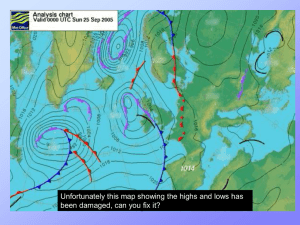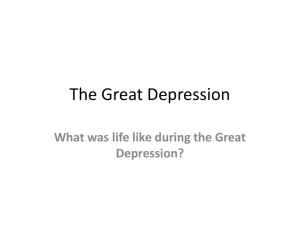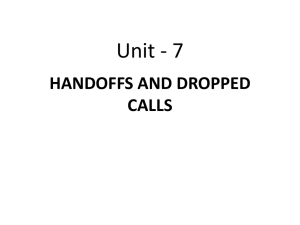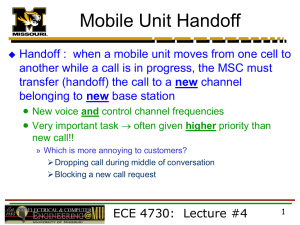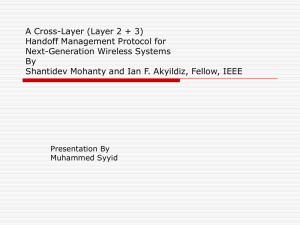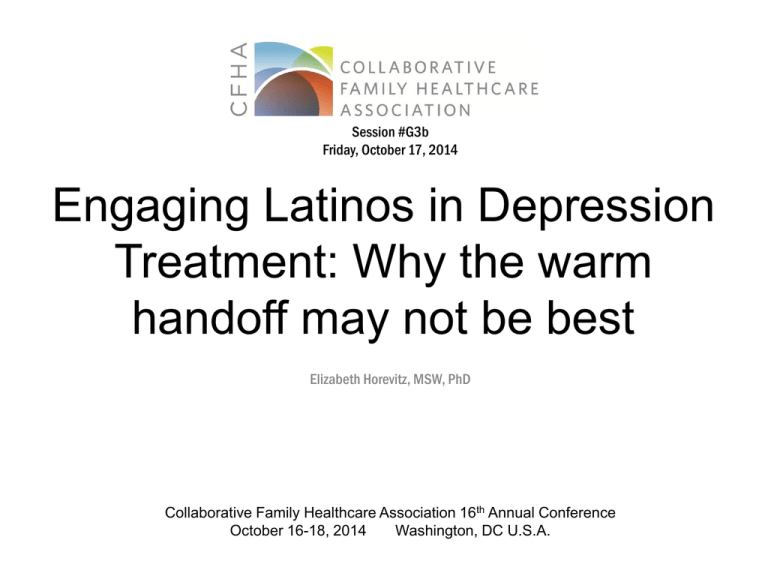
Session #G3b
Friday, October 17, 2014
Engaging Latinos in Depression
Treatment: Why the warm
handoff may not be best
Elizabeth Horevitz, MSW, PhD
Collaborative Family Healthcare Association 16th Annual Conference
October 16-18, 2014
Washington, DC U.S.A.
Faculty Disclosure
• I have not had any relevant financial relationships
during the past 12 months.
Learning Objectives
At the conclusion of this session, the participant will be able to:
• Critique the warm handoff as a “one size fits all”
approach in referral practices.
• Consider how the warm handoff is utilized in their own
practice setting.
• Discuss factors that influence effective engagement of
Latinos into depression treatment.
Bibliography / Reference
1. Fernandez y Garcia E, Franks P, Jerant A, Bell RA, Kravitz RL.
Depression Treatment Preferences of Hispanic Individuals:
Exploring the Influence of Ethnicity, Language, and Explanatory
Models. J Am Board Fam Med. 2011;24(1):39–50.
2. Cortes DE, Mulvaney-Day N, Fortuna L, Reinfeld S, Alegría M.
Patient—Provider Communication Understanding the Role of
Patient Activation for Latinos in Mental Health Treatment. Health
Educ Behav. 2009;36(1):138–154.
3. Zhang W, Creswell J. The Use of “Mixing” Procedure of Mixed
Methods in Health Services Research: Med Care. 2013
4. Dwight Johnson M, Apesoa-Varano C, Hay J, Unutzer J, Hinton
L. Depression treatment preferences of older white and Mexican
origin men. Gen Hosp Psychiatry. 2013;35(1):59–65
5. Ell K, Lee PJ, others. Depression Care for Low-Income, Minority,
Safety Net Clinic Populations With Comorbid Illness. Research
on Social Work Practice. 2010;20(5):467.
Learning Assessment
• A learning assessment is required for CE
credit.
• A question and answer period will be
conducted at the end of this presentation.
overview
•
•
•
•
Research background and driving questions
Methodology
Results
Implications for integrated primary care
Research background
Latinos & Depression
Depression is debilitating and costly for all populations
Latinos experience comparable rates of MDD as Whites (14% for
immigrants; 20% for US-born Latinos)
Disparately low rates of MH treatment-seeking
Mexican Americans half as likely to seek mental health treatment as
Whites
Typically seek care for depression in medical settings (stigma, access
issues, lack of culturally competent care)
Disparately low rates of follow-up on referrals to MH services (MH
treatment “uptake”)
“Our patients are simply lost to follow-up”
Estimates as low as 3%-6% (Ishikawa, 2011).
background
The Former Landscape
of Health Care in the
US:
-High costs and frequent
use of “safety nets”
-Fractured care (social
services down the
street?)
-Dichotomy: mind/body
-Primary care: de-facto
MH system
HEALTH
CARE
MENTAL HEALTH
CARE
Post-ACA FUTURE landscape of
healthcare
“A
team-basedcare
model
of care wherein
medical and
“Collaborative
is associated
with significant
mental
health in
providers
partner
facilitate
the
improvement
depression
and to
anxiety
outcomes
detection,
of psychiatric
compared treatment,
with usual and
care,follow-up
and represents
a useful
disorders
in
the
primary
care
setting.
It
is
an
addition to clinical pathways for adult patients with
appropriate
model
for treating mild to moderate
depression and
anxiety”
psychiatric disorders and for maintaining the treatment
of severe
psychiatric
disorders
(e.g.,
bipolar
disorder,
Archer
J, Bower
P, Gilbody S, Lovell
K, Richards
D, Gask
L, Dickens
C, Coventry P.
Collaborative
care for depression
and been
anxiety problems.
Cochrane
Database of
schizophrenia)
that have
stabilized”
(Hogg
Systematic Reviews 2012, Issue 10.
Foundation for Mental Health, 2008)
THE PROMISE OF THE WARM
HANDOFF
• The best thing since sliced bread?
The promise of ibh for latinos
“The importance placed on the relationship Latino patients have with their
primary care providers supports a service model that seamlessly extends
and generalizes this relationship to the behavioral health specialist. This is
the so-called warm handoff model… This extension forms the basis for
engagement of clients into behavioral health services via the primary care
clinic.”
--Manoleas, P., (2007), p. 443.
Access
Acceptability
Research has assessed treatment outcomes, but
we don’t know whether or how IBH may improve
MH treatment uptake
Is it really better than the old “silo” model? In what
way?
Is the warm handoff everything it is cracked up to be?
Purpose
PHASE I: To identify specific sociodemographic and contextual
factors in the referral process that predict mental health treatment
initiation for depressed Latinos within a naturalistic IBH setting.
Ho1: Patients who receive a warm hand-off referral type will be more likely
to attend an initial behavioral health visit than those who receive a cold
hand-off.
Ho2: Patients higher in acculturation will be more likely to attend an initial
behavioral health visit than those lower in acculturation.
Ho3: Patients with comorbid anxiety will be more likely to attend an initial
behavioral health visit than those without comorbid anxiety.
Purpose
•
PHASE II: To qualitatively understand why Latino patients decide to follow up or
not with behavioral health services for treatment of depression upon referral.
•
Study results have implications for reducing mental health utilization
disparities in Latinos, as well as illuminating factors that compose effective IBH
models.
Community health clinic ole
“The medical and dental home for Napa County’s underserved, providing high-quality,
affordable, compassionate and culturally sensitive primary health care”.
Behavioral Health Services
Targeted
Non-Specific
Background: Process of care
• PHQ-9
• 9+ (theoretically)
triggers referral
to BH
All medical patients
screened for
depression/anxiety sx
Referral to BH by PCP
• Show
(uptake/initiate)
• No-Show
• Warm Hand-Off
(WHO) or
• Cold Hand-Off
(CHO)
Behavioral health
treatment initiation
?
Predisposing
Enabling
Need
Methodology: Sequential mixed
methods
PHASE I:
Retrospective cohort design
Medical records review (N= 431)
Predictor analysis: Show/no show to initial BH visit
(dichotomous)
PHASE II: in-depth semi-structured interviews to
“dig deeper” into the decision to follow-up or not
with BH (60-90 minutes each)
Thematic analysis
Methodology PHASE I
Key predictor variable of interest:
Warm handoff vs cold handoff
Severity of depression (score on PHQ-9: 9-27)
Length of time between PCP visit and BH visit
Acculturation (language)
Co-morbid anxiety
Anti-depressants
Eth/Gen match PCP & pt; Eth/Gen match BHC & pt
PCP/Patient Alliance (proxy)
Income level
Insurance status
Sex
Age
Sample PHASE I (N=431)
• 73% Female; 27% Male
• Age: x̄ = 43.5; range: 19-86
• 81% Spanish-speaking; 19% English-speaking
• 78% Moderate depression-Moderately severe depression; 22% Severe
Depression
• 36% Warm handoff; 64% Cold handoff
• 52% on psychotropic medication
• 16% Co-morbid anxiety
• 79% at or below federal poverty level
• Days to initial BH appointment: Mean= 15 days (range: 1-56)
Findings PHASE I
The Good News: 52% attend initial BH visit.
The Surprising News:
Warm handoff, acculturation and comorbid anxiety
not predictors of depression treatment uptake
but…
Significant negative interaction effect between
English language and warm handoff (OR= 0.271, p =
.01).
In plain english
English speaking Latinos who received a warm
handoff were 4x less likely to attend an initial BH visit
than those who received a cold handoff referral.
MOMENT OF SILENCE
TO LET THAT SINK IN…
PHASE I: Other findings of interest
Table 1.5. Group differences by Language.
Characteristics
Anti-depressants
Yes
No
Co-morbid Anxiety
Yes
No
Depression Severity
(PHQ-9)
Insurance Status
Uninsured
Insured
Total
N = 431
n
223
208
%
(52%)
(48%)
Primary Spanish
N = 349
Primary English
N= 82
n
167
182
n
56
26
%
(48%)
(52%)
%
(68%)
(32%)
P-Value
*.001
.057
67
(16%)
364 (84%)
Mean (SD)
15.64 4.75
49
(14%)
300
(86%)
Mean (SD)
15.21
4.66
18
64
Mean
17.50
(22%)
(78%)
(SD)
4.70
*.000
*.033
222
176
(72%)
(44%)
191
131
(59%)
(41%)
31
45
(41%)
(59%)
Sample Phase II (N=16)
• 9 Spanish-speaking; 7 English-speaking
• 13 women; 3 men
• Depression scores:
– 11 Moderate; 4 moderately severe; 2 severe
• 9 Warm handoff; 7 Cold handoff
• 7 attended; 9 did not attend first visit
FINDINGS PHASE II
Depression narrative matters (meaning & healing)
Patients’ relationship with Clinic Ole matters
Patient-provider relationship is crucial
English-speakers more likely to report negative relationship with
provider and/or Clinic Ole
Experience of referral matters
Wide range of experience
Education about depression + match service to need is critical
Psychosocial barriers
*Readiness* and cost/benefit analysis (wait time)
Financial concerns
Confusion/misunderstanding
Health literacy issues
Depression narrative
• Gendered
• Influences beliefs about healing: MATCHING
Well,
uh,
well depression
that is to say, s- they sen-, the s- I felt it, like in itself,
Q:
How
should
one treat depression?
powerless to resolve my problems, that I would try to resolve my economic
problems,
my problems
f- doctor
family, prescribes
well let's say
tous.
survive,
of where to–live,
and uh,
The
medication
becauseof
the
it to
And counseling
because
oh, can
and talk,
I felt like
like me
I had
to I'm
hidetalking
in a place
where
onewell,
could
Well
if I out
owed
you
that
to you,
and,no
and,
likesee
youme.
need
to let
anyone money,
thatfeel
they
didn'tlike,
see all
me,ofbecause
I did what
not have
way what
of paying
everything
that you
inside,
our feelings,
you a
want,
you, uh,
themwant,
back.what
Or, uh,
or to be thinking
"Tomorrow
I going
come
with
don't
hasor,
happened
to us, what
we, whathow
we am
have
lived, to
like,
yes,up
I feel
so much
money
pay what is the, the, the rent, food, and all of that?" And uh, and,
like
that gives
us to
relief…
and at times I would think about, to myself I would say, I'm thinking of sleeping and
not waking up tomorrow.
-- Anabel; 45; Spanish-speaker; Did not attend first visit
-Matias, age 49, Spanish-speaker, Attended first visit
CHCO experience
It's convenient for me. As I told you, this clinic gives me
confidence, mostly because we are, there are Latinos, Latino
people like us, people – well yes, Latino people that speak Spanish
and everything, right? So I feel a confident coming here.
- Anabel
CHCO EXPERIENCE
• Provider-patient relationship
Q: Tell me about your relationship with your primary care provider.
Well
I don’t
that,
at least
withreally
the first
doctor,
he understood
whole
It's good,
it'sthink
really
good
we have
good
communication
withthe
each
other um it
depression
part
of it never
all.… because
don’tum
think
hemy
cared.
I guess
that’s
all happened,
I had
seen her Iuntil
I had
appendix
taken
outthe
in best
way
to put it.
tried to
him …
youValley
know and
they um
askityou
questions
November
andLike,
sheIcame
to tell
Queen
of the
wasthese
the first
time I ever
when
you
first
come
in,
you
know,
“Have
you
been
down
for
like
two
weeks?”
met her and then from there you know she you know ah referred me to come or,
back
you
all oflet
the
answers
were
prettyso
much
“Yes”…
I guess
kindanof
and know,
come and
see her,
her
know how
it went
it went
reallyAnd
good
it was Ilike
thought
maybe
he would
elaborate
you know,
like,I,“This
isn’ther.
normal,” you
instant um
I guess
you want
to say on
likethat,
connection,
really
I trusted
know, “How long have you been feeling this way?” And it was never a conversation
of
anything
that.
- Paola;
31;like
English-speaker;
Attended first visit
- Claudia; 32; English-speaker; Did not attend first visit.
REFERRAL EXPERIENCE
• Extreme variability of referral experience
• Impression of BH services is crucial
Can
you
tell just,
me about
experience
referred
tothen
behavioral
Well,
I, so,
what Iyour
should
do, well, being
cry and
cry and
get outhealth?
everything I have
Q:
It says
here
that
you saw
that same
day…give
tell me
me medicine
more about
that
inside.
Like
that
I, well,
it hit the
me counselor
like that. Well,
they don’t
to calm
Imeeting.
don’t
know,
just kind When
of feel Ilike
thethey,
girlsthey
ask didn’t
those want
questions
just to ask
Like,
me
down
or Ianything.
went
to attend
me. them.
They gave
maybe
not for for
the–benefit
of them,
butbut
if feels
likedepression.
it’s just something
have
do…
me medicine
for another
thing,
not for
… The they
nurse
just to
told
me
Well
Ithey
felt gooit’s just
that,
that was
what
I should
have
done,
to said
have
come,
You
whatgood,
I mean?...And,
um,
because
when
come
thehere
pastshe
they
ask“you
you
thatknow
gave
me
a little
piece
ofthat
paper…
She
toldI’ve
me,
herein
the,
because
moment
I had
courage
to tell So,
her Imy
problem,
I feltare
comfortable,
them,
andatthey
never
out the
a piece
of paper.
was
like, “Why
you asking
are going
tothat
see
this filled
one”…
andthese
from the
moment
toldgonna…
the doctor,
notgonna
the counselor,
sothem
then I,
I feltyou
comfortable,
me
things?
Are Iyou
really
remember
when
go back
and
with,
and
with
themy
idea
to CHO;
see her
[the
counselor].
feltLike
more,
fill
out
the
top of
paperwork?...
Itnot
feels
like something
they perfect,
have to Ido.
- Lola;
45;
Spanish-speaker;
Did
attend
firstWell
visit it was
well with I’m
more
desire
to come
andgoing
to telltoher
aboutthis?...
what it Next
is that
wasI upsetting
protocol.
like,
is anyone
even
askmore
me about
thing
know some
me.walks in the room…
girl
- Matias;
49;
Spanish-speaker;
warm
handoff;
attended first visit
Claudia;
32;
English;
WHO; Did not
attend
first visit
Psychosocial barriers & Pathways
The referral process was ... from [my doctor] was, um, excellent. She was
very indulging and, she was very ... attentive and ... you know, she really
wants me to come to the appointment. And, um Alicia was very nice. She was
Q: Why
did you decide
attend
the visit Um,
with they
the counselor?
very
understandable
just to
like
[my doctor].
both like, try to help you
They called
mecan,
to say
tothey
come
appointment,
to forget
about that
it. I they
said yes,
whenever
they
and
trytotomy
give
you advice not
on the
knowledge
Because
I Ididn’t
… going
I don’t
want
it to get
worse.
hoping
that
it don’t
getwant
worse
but
they
said
it was
bedoctor]
twenty
dollars.
said,
no, [my
told
me
I didn’t
have.
And
just
think
that to
[my
and
AliciaI I’m
like
they're
... doctor]
they
really
and
Itoknow
that
some
medications
areI just
… Iyou
know
work
orfeel
some
have
paywith
because
can’t
right now;
can’t;
don’t
havethey
She
youdo,
can
to
help
you
um
...I depression.
They
really
want
you
toenough.
getdon’t
better
andsaid,
so I’m
at the
point
where
I and
don’t
even
… talking
I don’t to
want
take
notokind
pay
later.
Ido
said,
no…
I feel
bad
and
I wanttowith
totake
keep
thatto
person
feel of
better
and
better
in If
life,
not
get want
stuck
depression,
like,
for
a long
medication
forbewhat
because
I’m already
a ton
for my
I’mit’s
better,
I won’t
ableI’m
to feeling,
do it. Why?
Because
I have on
to be
paying
andillness.
paying.SoSo
time.
just …toyou
know
I don’t
know, I just
… I want
think anything.
talking is good
youit.know.
better
cancel
the
appointment;
I don’t
Cancel
And my son said,
well, mom, if they’re charging you, why do you go? Instead of that, go for a walk. So
-Sandra;19; English-speaker; Warm Handoff; Did not attend first visit
Maria; 39;
Warm
Attended
first visit.
I--cancelled
it, English-speaker;
and I haven’t been
able Handoff;
to see any
counselor.
I haven’t.
Because,
um,
cancelled it on me.
Because
I apparently,
she wasn't
gonna make
- Rodelia;
56;they
Spanish-speaker;
cold
handoff;
did not attend
first visit.
it. So um, they never rescheduled another one with me. Uh they said they were, but
they never did. They just cancelled it, so I never came to talk to her.
summary
• Compared to silo model, our follow-up rate is good,
but could be better;
• English-speakers don’t seem to respond well to
WHO, but qualitative findings suggest that the
experience varies tremendously
• Several simultaneous factors appear to influence
follow-up…
enabling
predisposing
need
Followup
summary
• Depression narrative (meaning and healing)
• Relationship with clinic and medical provider
• Referral experience (hand-off or hand-hold? Matching
services to symptoms/narrative)
• Readiness & expectations/symptom acuity
• Everyday barriers ($, misunderstanding, scheduling conflict)
Implications & Discussion
- (Re)-Consider the Warm Handoff as a “best practice”
- What works, for whom, under what circumstances?
- Role of acculturation when we consider cultural compatibility
of the IBH model
- Centrality of the PCP-patient relationship (making the PHQ-9 a
meaningful tool)
- Check for understanding & motivation (health literacy, reinforce
plan); assess additional access barriers
Questions?
Thank you to Clinic Ole, and especially to the
participants in this study, who generously
shared their stories with me. They, like I do,
hope their stories will help improve care for all.
This study was generously supported by funding from: UC MEXUS, The Fahs Beck Fund
for Dissertation Research, and The Center for Latino Policy Research at the University
of California, Berkeley. I am also grateful for funding from UC Berkeley’s Dissertation
Year Fellowship, which supported me in my final year of research.
Contact:
Elizabeth.horevitz@gmail.com
Session Evaluation
Please complete and return the
evaluation form to the classroom monitor
before leaving this session.
Thank you!


